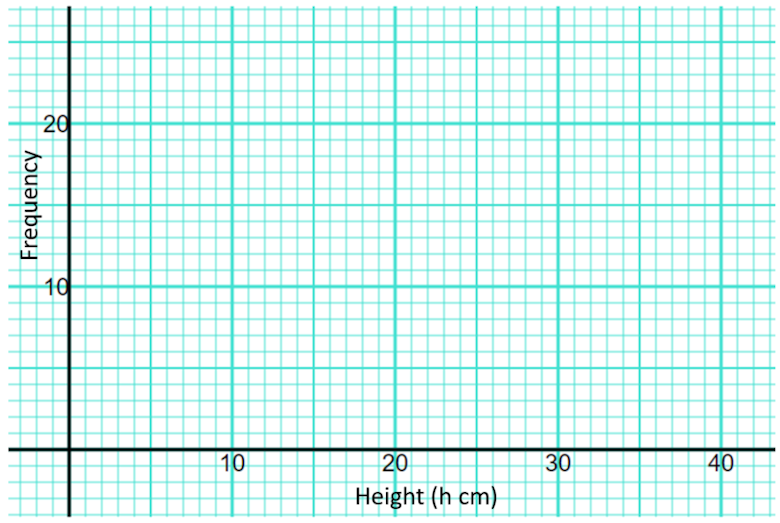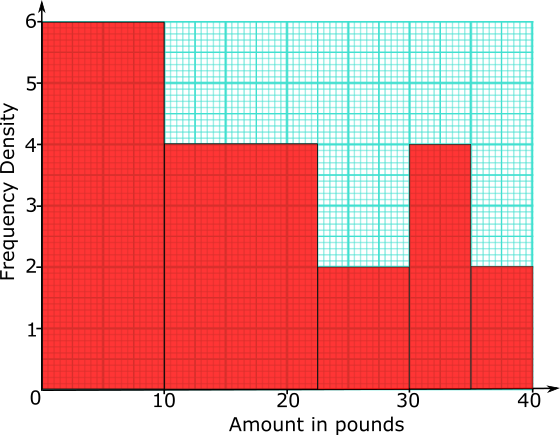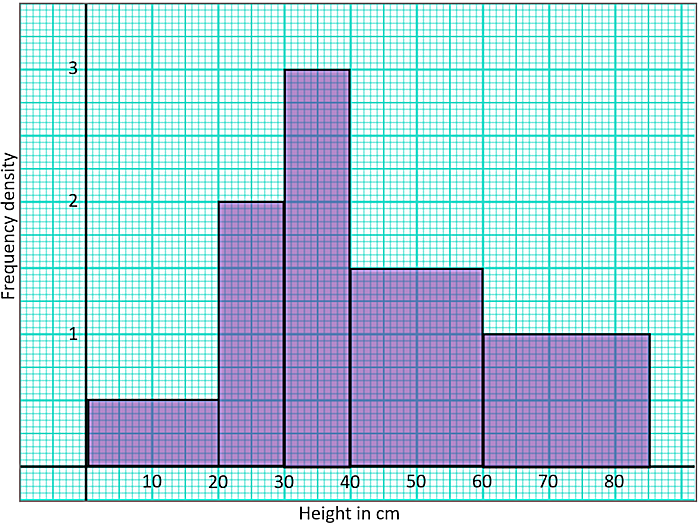
 |
Exam-Style Questions.Problems adapted from questions set for previous Mathematics exams. |
1. | GCSE Higher |
The table shows information about the heights of 85 stalagmites.
| Height (\(h\) cm) | Frequency |
|---|---|
| \(10\lt h \le 15\) | 9 |
| \(15\lt h \le 20\) | 13 |
| \(20\lt h \le 25\) | 18 |
| \(25\lt h \le 30\) | 22 |
| \(30\lt h \le 35\) | 15 |
| \(35\lt h \le 40\) | 8 |
(a) Find the class interval that contains the median.
(b) On the grid below, draw a frequency polygon for the information in the table.

2. | GCSE Higher |
The height, \(h\) cm, of each of 100 standing meerkats is measured. The table shows the results.
$$ \begin{array}{c|c|c|c|c} \text{Height (\(h\) cm)} & 20 < h \le 25 & 25 < h \le 30 & 30 < h \le 35 & 35 < h \le 40 \\ \hline \text{Frequency} & 8 & 42 & 39 & 11 \\ \end{array} $$Calculate an estimate of the mean.

3. | IGCSE Extended |

155 people were asked how much money they would pay for particular three-course meal in a special restaurant.
The histogram shows the results of the survey.
(a) Complete the frequency table for information shown in the histogram.
| Amount (£\(x\)) | \(0\lt x \le 10\) | ||||
|---|---|---|---|---|---|
| Frequency | 20 |
(b) Use your frequency table to calculate an estimate of the mean amount these people would pay for the meal.
4. | GCSE Higher |
The following table shows the time taken by fifty people to answer their emails one day.
| Time, t minutes | Number of people |
| 0 < t ≤ 10 | 5 |
| 10 < t ≤ 20 | 12 |
| 20 < t ≤ 30 | 13 |
| 30 < t ≤ 40 | 15 |
| 40 < t ≤ 50 | 5 |
(a) In which class interval is the median?
(b) How many people took more than 20 minutes?
(c) What is the modal class interval?
(d) Find an estimate for the mean time taken showing all of your working.
5. | GCSE Higher |
The following table show data collected by a researcher about the length of monitor lizards living in a park in Bangkok.
| Length (cm) | Frequency |
|---|---|
| \(0\lt l \le 50\) | 9 |
| \(50\lt l \le 100\) | 13 |
| \(100\lt l \le 150\) | 22 |
| \(150\lt l \le 200\) | 19 |
| \(200\lt l \le 250\) | 11 |
| \(250\lt l \le 300\) | 3 |
(a) Which is the modal group?
(b) Calculate an estimate for the mean lizard length.
(c) The researcher claims that the range of lengths must lie between 2m and 3m. Explain how the researcher came to this conclusion.
6. | GCSE Higher |
The histogram gives information about the distribution of the heights of some shrubs grown by a garden supplier.

The shrubs are on sale at the following prices:
A pie chart is drawn using the information above to show the number of shrubs in each price category. Calculate, to the nearest degree, the angle in the sector representing shrubs sold for £12.
7. | IB Standard |
The following table shows the number of days families spend in a particular seaside hotel in August last year.
| Days | Frequency | Cumulative frequency |
|---|---|---|
| 2 | 3 | 3 |
| 5 | 11 | 14 |
| 7 | 15 | 29 |
| 10 | \(x\) | 39 |
| 14 | 5 | 44 |
(a) Find the value of \(x\).
(b) Find the mean.
(c) Find the variance.
8. | IB Standard |
The personal trainer collected data from a randomly selected sample of days. From this he found that the number glasses of water he drank in a day had a mean of 4.35.
| Glasses | 1 | 2 | 3 | 4 | 5 | 6 | 7 |
|---|---|---|---|---|---|---|---|
| Frequency | 3 | 5 | 5 | 8 | \(x\) | 7 | 6 |
(a) Find the number of days represented by \(x\)
(b) Write down the standard deviation.
If you would like space on the right of the question to write out the solution try this Thinning Feature. It will collapse the text into the left half of your screen but large diagrams will remain unchanged.
The exam-style questions appearing on this site are based on those set in previous examinations (or sample assessment papers for future examinations) by the major examination boards. The wording, diagrams and figures used in these questions have been changed from the originals so that students can have fresh, relevant problem solving practice even if they have previously worked through the related exam paper.
The solutions to the questions on this website are only available to those who have a Transum Subscription.
Exam-Style Questions Main Page
To search the entire Transum website use the search box in the grey area below.